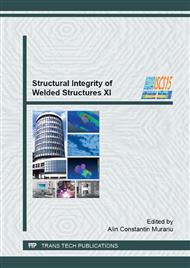[1]
A. Pourmousa, J. Mostaghimi, A. Abedini, and S. Chandra, Particle Size Distribution in a Wire-Arc Spraying System, J. Therm. Spray Technol., 2005, 14(4), pp.502-510.
DOI: 10.1361/105996305x76522
Google Scholar
[2]
St.L. Toma, C. Bejinariu, D.A. Gheorghiu, and C. Baciu -The improvement of the physical and mechanical properties of steel deposits obtained by thermal spraying in electric arc - Advanced Materials Research, Proceedings of ISCS13, Vol. 814 (2013).
DOI: 10.4028/www.scientific.net/amr.814.173
Google Scholar
[3]
A. Newbery, P. Grant, and R. Neiser, The Velocity and Temperature of Steel Droplets During Electric Arc Spraying, Surf. Coat. Technol., 2005, 195(1), pp.91-101.
DOI: 10.1016/j.surfcoat.2004.12.035
Google Scholar
[4]
J. Wilden, J.P. Bergmann, S. Jahn, S. Knapp, F. van Rodijnen, and G. Fischer, Investigation About the Chrome Steel Wire Arc Spray Process and the Resulting Coating Properties, J. Therm. Spray Technol., 2007, 16(5-6), pp.759-767.
DOI: 10.1007/s11666-007-9114-8
Google Scholar
[5]
T. Watanabe, X. Wang, E. Pfender, and J. Heberlein, Correlations Between Electrode Phenomena and Coating Properties in Wire Arc Spraying, Thin Solid Films, 1998, 316(1-2), pp.169-173.
DOI: 10.1016/s0040-6090(98)00409-x
Google Scholar
[6]
St.L. Toma, D.A. Gheorghiu, S. Radu, and C. Bejinariu, - The influence of the diffusion on adherence of the 60t deposits obtained through thermal spraying in electric arc, Applied Mechanics and Materials, Proceedings of IMaNE, Vol. 371 (2013).
DOI: 10.4028/www.scientific.net/amm.371.270
Google Scholar
[7]
A.L. Johnston, A.C. Hall, and J.F. McCloskey, Effect of Process Inputs on Coating Properties in the Twin-Wire Arc Zinc Process,J. Therm. Spray Technol., 2013, 22(6), pp.856-863.
DOI: 10.1007/s11666-013-9949-0
Google Scholar
[8]
D. Hale, W. Swank, and D. Haggard, In-Flight Particle Measurements of Twin Wire Electric Arc Sprayed Aluminum, J. Therm. Spray Technol., 1998, 7(1), pp.58-63.
DOI: 10.1007/s11666-006-5004-8
Google Scholar
[9]
Quality Designed Twin Wire Arc Spraying of Aluminum Bores J. Konig, M. Lahres, and Oliver Methner, J. Therm. Spray Technol., 2015, 24(1-2), pp.63-74.
DOI: 10.1007/s11666-014-0170-6
Google Scholar
[10]
St. L. Toma, The influence of jet gas temperature on the characteristics of steel coating obtained by wire arc spraying, Surface & Coatings Technology, Vol 220 (2013), pag. 261–265.
DOI: 10.1016/j.surfcoat.2012.12.006
Google Scholar
[11]
P.L. Fauchais, J.V.R. Heberlein, and M.I. Boulos, Gas Flow- Particle Interaction, Thermal Spray Fundamentals, Springer, New York, 2014, pp.113-226.
DOI: 10.1007/978-0-387-68991-3_4
Google Scholar
[12]
M. Malek, A. Hafiz, H.S. Nor, K.A. Sunhaji, and B.S. Noriyati, Critical Process and Performance Parameters of Thermal Arc Spray Coating, Int. J. Mater. Eng. Innov., 2014, 5(1), pp.12-27.
Google Scholar
[13]
A. Pourmousa, J. Mostaghimi, A. Abedini, and S. Chandra, Particle Size Distribution in a Wire-Arc Spraying System, J. Therm. Spray Technol., 2005, 14(4), pp.502-510.
DOI: 10.1361/105996305x76522
Google Scholar
[14]
H. -D. Steffens, Z. Babiak, and M. Wewel, IEEE Trans. Plasma Sci. 18 (6) (1989), 974.
Google Scholar
[15]
M. Abdulgader, The Correlation Between the Coating Quality and the Moving Direction of the Twin Wire Arc Spraying Gun, J. Therm. Spray Technol., 2010, 19(1-2), pp.409-421.
DOI: 10.1007/s11666-009-9452-9
Google Scholar
[16]
H.L. Liao, Y.L. Zhu, R. Bolot, C. Coddet, and S.N. Ma, Size Distribution of Particles from Individual Wires and the Effects of Nozzle Geometry in Twin Wire Arc Spraying, Surf. Coat. Technol., 2005, 200(7), pp.2123-2130.
DOI: 10.1016/j.surfcoat.2004.12.025
Google Scholar
[17]
M.M. Matz and M. Aumiller, Practical Comparison of Cylindrical Nozzle and De Laval Nozzle for Wire Arc Spraying J. Therm. Spray Technol., 2014, 23(1-2), pp.1470-1477.
DOI: 10.1007/s11666-014-0156-4
Google Scholar
[18]
S.L. Toma, C. Bejinariu, R. Baciu, and S. Radu, The Effect of Frontal Nozzle Geometry and Gas Pressure on the Steel Coating Properties Obtained by Wire Arc Spraying, Surf. Coat. Technol., 2013, 220, pp.266-270.
DOI: 10.1016/j.surfcoat.2012.11.011
Google Scholar
[19]
Tillmann W., Abdulgader M., Anjami N., and Hagen L., Studying the Effect of the Air-Cap Configuration in Twin-Wire Arc-Spraying Process on the Obtained FlowCharacteristics Using Design of Experiment Oriented Fluid Simulation, J. Therm. Spray Technol., 2015, 24(1-2), pp.46-54.
DOI: 10.1007/s11666-014-0183-1
Google Scholar
[20]
N.A. Hussary and J.V.R. Herberlein, Atomization and Particle-Jet Interactions in the Wire-Arc Spraying Process, J. Therm. Spray Technol., 2001, 10(4), pp.604-610.
DOI: 10.1361/105996301770349123
Google Scholar
[21]
Technical Data Buletin Praxair & Tafa (2010) File 1. 9. 1. 2 – 14T (K10320).
Google Scholar


